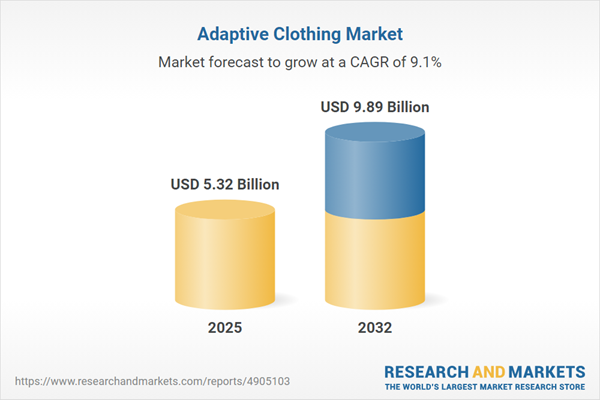Speak directly to the analyst to clarify any post sales queries you may have.
The adaptive clothing market is undergoing a significant transformation as apparel manufacturers and brands increasingly embrace inclusive design and innovative technologies. With shifting consumer expectations and intensifying regulatory focus, organizations that act nimbly and responsively are best positioned to capture new growth opportunities in this evolving B2B sector.
Market Snapshot: Adaptive Clothing Market Growth
The adaptive clothing market grew from USD 4.91 billion in 2024 to USD 5.32 billion in 2025, with continued expansion projected at a CAGR of 9.14% to reach USD 9.89 billion by 2032. This upward momentum is driven by dynamic shifts in consumer preferences, development in assistive design, and strengthened global accessibility standards. Apparel providers are rapidly investing in this segment, responding to demographic changes and rising demand for clothing that addresses a wider variety of functional needs.
Scope & Segmentation of the Adaptive Clothing Market
This comprehensive industry analysis covers adaptive clothing market trends across diverse dimensions, offering actionable granularity for precise market entry and resource alignment. The report details key segments, helps assess competitive dynamics, and supports strategic positioning as regulatory and end-user priorities shift.
- Disability Types: Apparel solutions serving autism, dementia, amputees, elderly mobility, wheelchair users, hearing impairment, touch sensitivity, blindness, and low vision enable inclusive growth and diversified product lines.
- Distribution Channels: Strategies cover department stores, medical supply stores, specialty retailers, branded websites, and leading e-commerce platforms, supporting varied approaches to regional and global reach.
- End User Categories: Solutions are developed for men, women, assisted living, independent living, children, infants, and toddlers, responding to multi-generational demand for adaptive apparel.
- Product Types: The market encompasses belts, straps, headwear, jewelry, pants, shorts, skirts, casual footwear, formal and sports footwear, blouses, jackets, and shirts, reflecting innovation tailored to diverse mobility needs.
- Regional Scope: Analysis spans North and South America, Europe, the Middle East, Africa, and Asia-Pacific, with key countries such as the United States, Canada, Brazil, United Kingdom, Germany, United Arab Emirates, South Africa, China, India, Japan, and Australia—illustrating both mature and emerging market opportunities.
- Key Companies: Market leaders driving adaptive clothing innovation include Nike, Target Corporation, PVH Corp, American Eagle Outfitters, Zappos.com, MagnaReady, M. Silver Corp, Buck & Buck, Tommy Hilfiger licensing, and Unhidden-UK Limited.
- Technologies: The adoption of advanced material science, integration of smart textiles and wearable electronics, AI-enabled quality control systems, on-demand manufacturing, and AR-driven product simulation accelerates functional product development and enhances the customer experience.
Key Takeaways for Senior Decision-Makers
- Adaptive clothing is shifting from a single-function solution to a central differentiator for many global apparel brands, aligning with contemporary universal design best practices.
- Direct engagement with end users significantly influences design and performance outcomes, facilitating higher adoption rates and fewer product returns across all user categories.
- Technology alliances facilitate the rollout of garments with health tracking and responsive features, expanding use cases into wellness and daily living beyond conventional assistive apparel.
- Retail and distribution models are evolving, with hybrid approaches and enhanced regional micro-fulfillment boosting both the accessibility and customization of product offerings.
- Transparent supply chain management has become a priority, enabling compliance with regulatory requirements and addressing consumer demand for responsible sourcing in manufacturing operations.
- Growth potential is strongest in regions investing in digital channel infrastructure, robust public-private collaboration, and the upskilling of a specialized workforce for adaptive clothing production.
Tariff Impact on Sourcing and Cost Structures
Forthcoming U.S. tariff changes are set to raise costs for adaptive clothing manufacturers sourcing specialty textiles and components internationally. Decision-makers must re-evaluate sourcing by considering increased use of domestic suppliers and strategic nearshoring. Automation and enhanced production processes present avenues to manage inflationary pressures, while transparent communication around ethical sourcing practices helps sustain stakeholder trust.
Methodology & Data Sources
This report synthesizes insights using qualitative and quantitative research, supported by industry interviews, site visits, and structured surveys. Advanced analytics, such as sentiment analysis and conjoint modeling, deepen understanding of adoption drivers. Findings are validated by industry peer reviews and specialized advisory panels to ensure accuracy and credibility.
Why This Adaptive Clothing Market Report Matters
- Delivers tailored segmentation and regional analysis essential for focused market entry and investment strategy.
- Equips leaders with actionable insights into emerging design, digital, and compliance trends critical for maintaining a competitive advantage.
- Provides an evaluation framework for anticipating tariff impact and understanding regulatory movements across diverse jurisdictions.
Conclusion
The adaptive clothing sector presents compelling opportunities for organizations that champion innovation and inclusive design. Those prepared to cultivate strong partnerships and respond to regulatory shifts will strengthen market resilience and achieve sustainable growth.
Additional Product Information:
- Purchase of this report includes 1 year online access with quarterly updates.
- This report can be updated on request. Please contact our Customer Experience team using the Ask a Question widget on our website.
Table of Contents
3. Executive Summary
4. Market Overview
7. Cumulative Impact of Artificial Intelligence 2025
List of Figures
Samples

LOADING...
Companies Mentioned
The key companies profiled in this Adaptive Clothing market report include:- Nike, Inc.
- Target Corporation
- PVH Corp
- American Eagle Outfitters, Inc.
- Zappos.com, Inc.
- MagnaReady LLC
- M. Silver Corp
- Buck & Buck, Inc.
- Tommy Hilfiger licensing, LLC
- Unhidden-UK Limited
Table Information
| Report Attribute | Details |
|---|---|
| No. of Pages | 186 |
| Published | October 2025 |
| Forecast Period | 2025 - 2032 |
| Estimated Market Value ( USD | $ 5.32 Billion |
| Forecasted Market Value ( USD | $ 9.89 Billion |
| Compound Annual Growth Rate | 9.1% |
| Regions Covered | Global |
| No. of Companies Mentioned | 11 |









